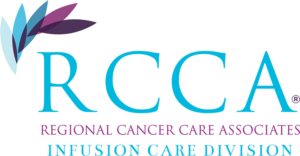Iron Deficiency Anemia
Iron Deficiency Anemia
Iron Deficiency Anemia Treatment in NJ, CT, MD, and the Washington, D.C., Area
Iron is a key nutrient, in part because it helps red blood cells carry oxygen throughout the body. If people’s diets lack the proper amount of iron, they can develop iron deficiency anemia, or IDA. The most common type of anemia, IDA affects 16% of the global population, mostly women and children.
While IDA sometimes can be treated successfully with oral iron supplements, many people cannot tolerate these medicines are do not achieve sufficient improvement with them. As a result, many patients with IDA requires iron infusion therapy. The medical oncologists and hematologists of Regional Cancer Care Associates (RCCA) draw on their experience with chemotherapy to deliver infusion services for patients with cancer and many other conditions, including iron deficiency anemia. Treatment is available at more than 20 locations across New Jersey, Connecticut, Maryland, and the Washington, D.C., area.
therapies offered
 What Is Iron Deficiency Anemia?
What Is Iron Deficiency Anemia?
Iron helps the body produce red blood cells. When iron is low, the body creates fewer red blood cells, and they are smaller than normal. Iron also enables the body to make hemoglobin, the protein in red blood cells that carries oxygen from the lungs to the rest of the body. It also helps produce myoglobin to bring oxygen to the muscles. Because iron deficiency anemia inhibits oxygen from flowing throughout the body, it can lead to a host of problems, ranging from fatigue to serious cardiac conditions.
Understanding Anemia
IDA is just one of several types of anemia. Some types, such as pernicious anemia, are caused by a nutritional issue. Others, such as sickle cell anemia, are inherited or caused by abnormalities in red blood cells (hemolytic anemia).
Of these different types of anemia, IDA is the most prevalent. Some research suggests that 2% to 5% of females and 2% of males in the United States have iron deficiency anemia, accounting for millions of individuals.
The Role of Iron in the Body
The body absorbs only a small amount of iron from food intake. When a person ingests iron, the mineral is absorbed by cells that line the gastrointestinal (GI) tract. When iron is released into the bloodstream, it carries a protein called transferrin to the liver, where it is stored as the protein ferritin. This protein is released whenever the body needs to make more red blood cells in the bone marrow.
After about 120 days of circulating throughout the body, red blood cells lose their functionality and are absorbed into the spleen. However, the body still can use the iron from these old cells to transfer iron to parts of the body. In addition to helping create hemoglobin and myoglobin, iron aids in the function and production of different cells and hormones. It also supports brain development in children.
Causes of Iron Deficiency Anemia
Several conditions can lead to iron deficiency, and thus anemia. Common causes include:
- Inadequate dietary intake: Diets low in iron-rich foods can lead to deficiency.
- Malabsorption issues: Some conditions cause absorption problems, such as rare genetic disorders and intestinal and digestive conditions. Surgery on the stomach and intestines, such as weight loss procedures, also can cause malabsorption.
- Chronic blood loss: Blood loss means iron loss. Examples of chronic blood loss include bleeding in the GI tract and urinary tract, bleeding after an injury or surgery, and heavy menstruation.
- Pregnancy and lactation: More blood is required to support the growth of the fetus, which means more iron is needed. Many pregnant women take prenatal vitamins to increase their iron intake.
Signs and Symptoms of Iron Deficiency Anemia
Iron deficiency anemia is a progressive condition, meaning symptoms can be mild at first and worsen with time unless patients receive the right treatment. Common signs of the disease include:
- Fatigue and weakness
- Dizziness
- Pale or yellow (sallow) skin
- Brittle nails or hair loss
- Shortness of breath
- Chest pain, especially during activity
- Headaches, especially during activity
- Faster heartbeat
- Cold sensation, especially in the hands and feet
- Pounding, whooshing feeling in the ears
- Craving for ice or compulsive ice chewing (pagophagia)
Diagnosing Iron Deficiency Anemia
Diagnosis of iron deficiency anemia begins when a patient visits his or her primary care provider for a physical examination and medical history. To confirm the diagnosis, most physicians will order blood tests, including a complete blood count (CBC).
CBC tests look at all the components of the blood, including red blood cells, white blood cells, hemoglobin, platelets (which help with blood clotting), and hematocrit (the percentage of total blood volume consisting of red blood cells). This panel provides key information for diagnosing iron deficiency anemia, including hematocrit levels, hemoglobin levels, and red blood cell size. Other blood tests and laboratory markers for IDA include:
- Red blood cell color as seen with a microscope (pale red blood cells suggest iron deficiency anemia)
- Iron levels in the blood
- Transferrin/ferritin levels
- Fecal occult blood test (to see if there is blood in stools)
- Urine test to detect the presence of blood or hemoglobin
- Colonoscopy, endoscopy, or similar procedure to identify abnormalities in the GI tract
In investigating the cause of anemia, a physician may also order tests to look for kidney disease, inflammatory disorders, autoimmune diseases, and blood disorders like sickle cell disease and thalassemia.
If the cause of a patient’s anemia remains unclear after these tests, providers may refer patients to hematologists, such as those at Regional Cancer Care Associates, for further evaluation.
Treatment Options for Iron Deficiency Anemia
Once the diagnosis of IDA is confirmed, a doctor will identify the most appropriate treatments based on the specific needs and concerns of the patient.
Dietary Changes and Iron-Rich Foods
To start, physicians may recommend that patients alter their diets to include more iron-rich foods. Foods that can help boost iron levels include:
- Meat and poultry (beef, pork, lamb, chicken, turkey)
- Dark meat and organ meat, such as the liver, are particularly iron-rich)
- Fish (shellfish, shrimp, sardines)
- Leafy greens (spinach, broccoli, kale)
- Legumes (soybeans, lima beans, pinto beans, peas)
- Squash and pumpkin seeds
- Dried fruit (raisins)
- Eggs
- Tofu
- Iron-fortified grains, cereals, pasta, and rice
Iron Supplementation
Physicians prescribe iron supplements in milligrams (mg) of elemental iron. Many patients with iron deficiency require 150-200 mg of elemental iron daily. This amount is significantly higher than what is found in the average multivitamin. For this reason, some patients may need special iron supplements to increase their levels.
Doctors might also prescribe multivitamins if diagnostic tests reveal below-average levels of other vitamins and minerals.
It can take three to six months for iron levels to reach the proper range after someone begins taking supplements. Possible side effects of iron supplements are constipation and black or dark stools. Patients should consult their healthcare providers for safe ways to treat these side effects. It may be recommended to switch to a plant-based supplement to minimize digestive trouble.
Infusion Therapy
For patients with more serious cases of iron deficiency anemia, infusion therapy may be necessary. With infusion therapy, patients receive iron intravenously. After just one or a few sessions, iron levels will increase. Patients who may benefit from infusion therapy include:
- Those unable to tolerate iron
- Those who do not absorb iron well in the GI tract
- Those with significant deficiency or chronic blood loss
- Those receiving supplemental erythropoietin (a hormone that activates blood production)
Physicians will refer patients to hematologists for infusion therapy. How long infusion therapy takes each session will depend on the unique needs of the patient and the severity of the case. Most patients experience minimal side effects.
Patients are encouraged to bring headphones or a book to occupy the time, or they can just rest during the treatment. At Regional Cancer Care Associates, patients will find board-certified physicians and infusion nurses nearby to monitor progress and answer questions.
Red Blood Cell Transfusions
In severe cases of IDA, patients may require red blood cell transfusions to quickly boost their iron and red blood cell counts. These cases typically involve active bleeding or more-concerning symptoms, such as weakness, shortness of breath, and chest pain.
While transfusions can boost red blood cell counts, ultimately, the cause, and not just the symptoms, of IDA must be identified to treat the condition effectively on an ongoing basis.
Potential Complications of Iron Deficiency Anemia
Treatment for iron deficiency anemia is vital not only for ensuring that the body maintains the proper iron levels but also because the condition can cause more serious complications. Possible complications include:
- Fatigue
- Headaches
- Heart issues and cardiovascular risks
- Cognitive impairment and stunted development
- Increased chance of infection
- Complications with pregnancy
- Restless leg syndrome
In patients with other conditions, iron deficiency anemia can make symptoms worse or diminish the effectiveness of treatment.
Preventing Iron Deficiency Anemia
People can reduce their likelihood of developing iron deficiency anemia by being aware of its risk factors, such as:
- Undergoing major surgery or experiencing physical trauma
- Undergoing bariatric procedures, particularly gastric bypass
- Having certain conditions, including:
- GI diseases (celiac disease)
- Inflammatory bowel diseases (ulcerative colitis)
- Crohn’s disease
- Peptic ulcer disease
- Heavy menstrual periods
- Pregnancy and breastfeeding
Another risk factor for iron deficiency anemia is eating a vegetarian or vegan diet low in iron. Although eating vegan and vegetarian offers numerous health benefits, individuals should ensure that they get enough iron from non-meat or dairy products. Options include leafy greens, beans, tofu, and dried fruits.
In children, exceeding the recommended daily intake of cow’s milk (16 to 24 ounces) can increase the risk of iron deficiency anemia. Too much cow’s milk can cause malabsorption of iron and affect the intestinal lining, potentially leading to blood loss.
Lifestyle Modifications for Anemia Management
In addition to changing their diet and obtaining treatment, individuals can take steps to manage the symptoms of iron deficiency anemia. For instance, because the condition can cause fatigue, patients can focus on optimizing their sleep quality to mitigate feelings of tiredness.
Becoming more physical active also can help, but patients should keep in mind that chest pain and headaches can become more intense with exercise. Engaging in physical activity in short intervals throughout the day can help limit these symptoms and ensure patients get the exercise they need. Further, any person who experience chest pain on exertion – or at rest, for that matter – should promptly consult his or her physician or seek emergency medical attention.
As with any condition that causes significant symptoms, iron deficiency anemia can be stressful. Individuals can consult their physicians to learn techniques for managing stress when diagnosed with iron deficiency anemia.
Trust the Comprehensive Care at RCCA
Inadequate iron intake can make it difficult for red blood cells to supply oxygen to meet the body’s needs. As a result, IDA can cause a host of adverse symptoms, such as fatigue and weakness, but patients can find treatment tailored to their diagnosis and unique health needs.
At Regional Cancer Care Associates, the team of medical oncologists, hematologists, advanced practice providers and nurse clinicians administers infusion therapy for many conditions, including iron deficiency anemia. Patients can obtain care from compassionate and experienced clinicians in comfortable, convenient community-based care centers across New Jersey, Connecticut, Maryland, and the Washington, D.C., area. Contact Regional Cancer Care Associates today to learn more about various conditions and treatments, or visit one of the nearest locations for care.
CONVENIENT LOCATIONS IN NEW JERSEY, CONNECTICUT, MARYLAND, AND THE WASHINGTON, DC AREA
For more information, or to schedule an appointment, call 844-474-6866. You can also schedule an appointment by calling the RCCA location nearest you.

 What Is Iron Deficiency Anemia?
What Is Iron Deficiency Anemia?